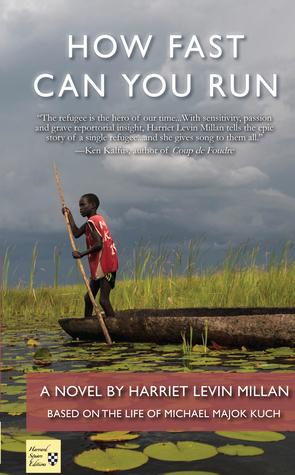
In 2000, the U.S. government granted political asylum to almost 4,000 unaccompanied minors from South Sudan. These so-called “lost boys” had survived deadly fighting between the Sudanese government and the Sudanese People’s Liberation Army during the country’s second civil war. Many had walked thousands of miles, seeking shelter in Ethiopia before being expelled back to Sudan or to refugee camps in Kenya. Some of these children saw their families killed in government-led attacks on their villages. They fled wild animals and survived days without ample food or water. Resettlement in the U.S. provided Sudanese refugees access to education, employment and valuable resources. It could not, however, ease the gravity of their loss.
Harriet Levin Millan’s debut novel How Fast Can You Run is based on extensive interviews with one of those boys, Michael Majok Kuch. At five years old, Majok Kuch Chol-Mang’aai flees his rural village on foot during an attack that separates him from his family. The novel recounts his trek from Sudan to refugee camps in Ethiopia and Kenya before eventually immigrating to the U.S. as a teen. Majok thrives at school in Philadelphia while battling recurrent memories of childhood trauma. He is intent on using American resources to locate his parents, whom he believes are living in Africa. The possibility of their death looms throughout the book, threatening to unravel his progress and emotional health. For all Majok gains access to in the U.S., he is still a young person on his own, struggling to figure out what he wants and who he can trust. This coming of age is intensified in the last section of the novel when a college classmate accuses him of a violent crime.
It’s hard to read about such a difficult childhood and not think about the apparent randomness of our lives. Majok and I are roughly the same age, and in the beginning of the book I found it hard to stop noting the differences between us, wondering why I was born into so many comforts not available to him and others. But the experience of reading How Fast Can You Run is much more than a corrective on privilege. Millan, an established poet, takes care to depict Majok’s early years in clean, precise prose, staying at his eye level as he goes into the wilderness alone:
Majok stopped walking and stood at the bottom of a tree, pushing through the vines that covered it to look for his mother. He hugged the tree and called for her. He was convinced that his mother had run into the swamp like he did and was hiding somewhere.
This intimacy with the protagonist helped me break free from comparisons and immerse myself in the story. Majok’s yearning for his mother is painfully exact, and one needn’t have experienced the same loss to recognize its authenticity. Millan’s careful portrayal of primal emotions—love for one’s family, pain of separation—makes Majok’s exceptional circumstances feel entirely relatable.
One of the most striking aspects of the novel is how it uses setting to convey internal and external tension. Half of the story takes place in Philadelphia, a city depicted as deeply flawed in its own ways. Majok arrives for his first day of high school and notices the “grand front entrance was boarded up with wood spray-painted in black and silver graffiti, the letters so slanted they looked like they were written in Arabic.” For all of the hardships Majok experienced, he finds life at an inner-city school intolerable. Millan doesn’t present resettlement as a perfect solution for Sudanese refugees, but a transition fraught with complexities. The immense cultural differences overwhelm Majok, and he encounters racism as well as profound generosity in Philadelphia. I rooted for him to succeed in this city while also understanding that it would never be his home. The distinction between continents becomes particularly important in the last section of the novel, when criminal allegations against Majok pose grave consequences for any surviving relatives in Sudan.
At its heart, How Fast Can You Run is arguably a story about healing from trauma and trying to envision the future. The narrative tension is strongest in the second half of the book, when Majok begins to confront the possibility that his parents are gone. Millan pulls us close into his perspective, showing how the constant urge to run toward his family sometimes prevents him from connecting with others. For Majok, committing to a future in the U.S. feels like giving up on the prospect of resuming life with his family in Sudan. The novel brilliantly conveys how he carries the cumulative weight of his experiences, sometimes feeling most exhausted by it in quiet moments. Healing is not a straight trajectory, but a winding path through surprising places. I finished the book feeling more connected to Majok than separate, reminded of how much we all want the same things. How fragile we are, and how resilient.
How Fast Can You Run
by Harriet Levin Millan
Harvard Square Editions, 2016
$18.86 paperback; ISBN: 978-1-941861-20-2
294 pages
Nicole Banas' fiction and essays have appeared most recently in The Missouri Review and the South Dakota Review. She lives near Philadephia and works as a legal journalist.
